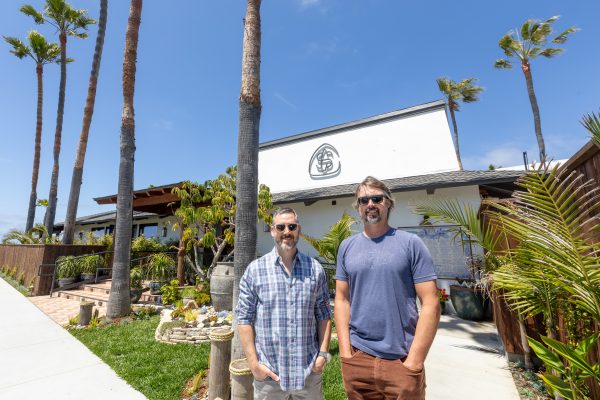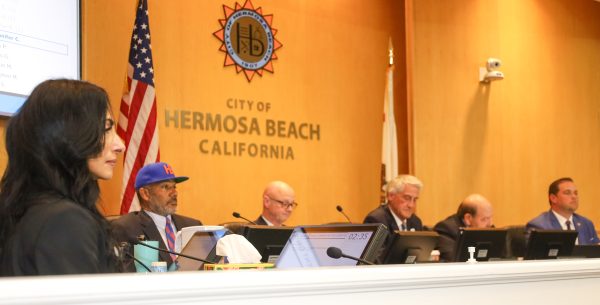
Hermosans wondering what an oil site in their city would look like can get a good idea by driving 45 minutes south to Huntington Beach.
The Argus oil facility in Huntington is operated by E & B Natural Resources and sits within a residential community, much like the proposed drill site at the Hermosa Beach city maintenance yard. Like Hermosa’s potential site, it contains 30 wells and pumps for directional drilling to extract oil from 166 acres surrounding.
Louis Zylstra runs the site and is the head of all the E & B facilities in the Los Angeles area. While giving a tour of the property, he immediately mentioned the low noise level.
“That hum you hear is as loud as it gets,” he said. “We should call the dog catcher because the loudest thing in the neighborhood is that dog barking.”
The only piece of equipment on the site that produces much noise is a water injection pump, which is responsible for the hum. Its sound clocks in at 90 decibels, about the level of a lawn mower. The pump is surrounded by a sound-mitigating 35-foot wall leaving its noise around 60 decibels, comparable to a running air conditioner.
The Huntington facility churns out about 11,000 barrels of water and oil per day, resulting in about 110 barrels of actual oil. In its heyday, the site produced 30,000 barrels with a much higher concentration of oil. Drill sites have diminishing returns and are most productive and valuable in their early years.
“Hermosa will be much more productive,” Zylstra said. “You can expect about 8,000 barrels per day of oil. That’s going to make you about $800,000 a day in revenue [at $100 per barrel].”

Zylstra is confident about Hermosans approving oil drilling at the March 3 election and speaks about the beach city project as if it’s a foregone conclusion.
“In Hermosa, we’ll be using state-of-the-art drilling technology,” he said. “With directional drilling and geo-steering we can extract much more oil and do it very safely.”
Zylstra then launched into a full-blown engineering lesson, explaining with diagrams how the oil wells are drilled, the oil extracted and the oil and water mixture demulsified. The drill creates a 12-and-a-half inch hole and the pipes are laid down at a 45 degree angle in order to have maximum contact with the oil and water below. The Hermosa wells would be drilled at a flatter angle, increasing the collection area by 89 percent.
The Huntington site contains two cellars with 18 wells in each. Hermosa would have a similar set up, though the cellars would be two feet deeper. Zylstra said that, since the pressure pushing the oil up the drill is depleted on its way to the surface, very little pressure remains when it gets there, eliminating the risk of a major blowout or kick.
“The drill bit is directed by two GPS systems and a magnetic device,” he said. “A mud motor spins the drill bit and then that mud is collected in pits and reused. Some people think the mud isn’t safe to use. Well, Glen Ivy Hot Springs uses our mud.”
“If they want the leftover mud, we’ll build you a spa,” he said, laughing.
Zylstra says the site hasn’t had any smell complaints in months. When E & B first took over operations at the Argus facility in 2012, many neighbors complained about the smell.
“I think it was more of a psychological effect,” he said. “They saw us working, once person would mention a smell and then a bunch of calls would come in.”
In order to reach out to the community, Zylstra organized a holiday party last year. He invited the neighbors to the yard for a big Italian dinner and celebration. There have been no negative comments about the yard since, he said.
Now that the Argus site is in its twilight, it only requires two or three employees to monitor it. They do hourly checks throughout the yard, checking temperatures and inspecting the tanks and wells.
“It will be the same in Hermosa,” Zylstra said. “One it’s up and running, we will only need two or three people there. Plus, Huntington has older technology. In Hermosa, we will have all of the readings, pressure and temperatures available to monitor on the computer system. We will set up alarms and have even better safety measures.”
Zylstra isn’t concerned about the safety of his site. It has never had an accident, and procedures are put in place to squash any problem quickly.
“We have higher safety ratings than most gas stations,” he said. “The only way oil is dangerous is if you inhale it, and that’s not going to happen.”










